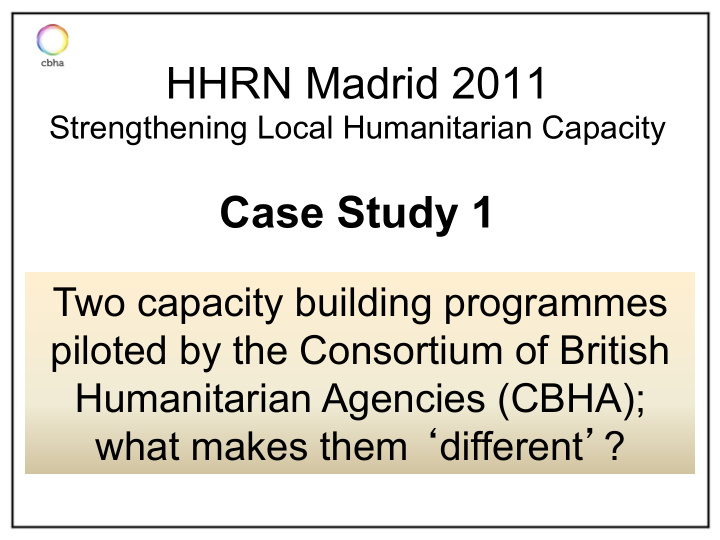



HHRN Madrid 2011 Strengthening Local Humanitarian Capacity Case Study 1 Two capacity building programmes piloted by the Consortium of British Humanitarian Agencies (CBHA); what makes them ‘ different ’ ?
Outline • What is CBHA? • What is the capacity building element of CBHA? • Common threads • Case studies • How have programmes evolved?
Overview of the Consortium of British Humanitarian Agencies • The CBHA is a ground breaking initiative, for strengthening the coordination and capacity of the NGO sector to deliver appropriate, high quality, quicker humanitarian assistance to populations affected by disaster.
DFID awarded the CBHA an initial two-year Memorandum of Understanding (MOU) of £8million. March 2010 – February 2012
The 5 Outputs of CBHA CBHA Emergency Capacity Technology & Learning & Response Building Surge Capacity Innovation Evaluation Fund Programme
Capacity Building Programme Goal: To develop capacity within the consortium of 15 leading UK agencies, and also the sector as a whole. Objectives: 1. Develop shared standards, competency and leadership behaviour frameworks and training resources for humanitarian response to apply to new and existing staff at the national regional and international level (ActionAid) 2. Develop core humanitarian skills and leadership and management competencies of existing staff at national and regional level (Oxfam GB with the ECB Project) 3. Increase the numbers of potential leaders brought into the humanitarian sector and trained in humanitarian management skills (Save the Children)
Putting the Core Humanitarian Competencies Framework into action … CBHA Capacity Building Programme 1. Increasing skills 2. Increasing through staff development availability of resources Surge Grant of £110,000 over 1a. Establish common competencies & leadership framework 2 years to each member agency 1c. International/ Regional training 1b. National Learning Programmes Bangladesh UK (London) Bolivia Horn of Africa (Nairobi) Indonesia Horn of Africa
Common threads in the three initiatives • CBHA Humanitarian Competencies Framework • Inter-agency approach • Collaboration • Contextualised materials
Case Study: Objective 2 The collaborative approach: Who is involved and where? The ECB Project, CBHA and beyond Who are the final materials for?
National Staff Development Programme (Objective 2) Humanitarian Management Humanitarian Core & Leadership Skills Skills Development Development Programme Programme 2-3 hours/week over 6 months 2-3 hours/week over 9 months Horn of Africa (Kenya, Somalia, Horn of Africa (Kenya, Somalia, Sudan), Bangladesh, Sudan), Bangladesh, Bolivia, Indonesia Bolivia, Indonesia
The Participant’s Journey
A typical participant? … reflections so far …
Case Study: Objective 3 – What is the HLDP? – What does the training element of the trainee scheme involve? • Simulation-based and Experiential Learning: Emergency operations programme (EOP) EFC (Emergency Foundations Course) Distance learning AFT (Advanced Field Training)
CBHA ¡Humanitarian ¡Leadership ¡Development ¡Programme 6 ¡months ¡HQ ¡& ¡training ¡Placement ¡ 6 ¡months ¡Field ¡Placement ¡ Includes ¡HQ ¡ToR ¡and ¡projects Includes ¡Field ¡ToR ¡and ¡projects ¡ Distance ¡Learning ¡(13 ¡wks) 15 ¡trainees ¡for ¡CBHA ¡ = programme ¡based ¡at ¡15 ¡CBH ¡ E ¡ A ¡(2 ¡ agencies F ¡ F ¡wks) ¡ C ¡ T 0 months 6 months 12 months TIMELINE
The Trainee development process • 4 stage trainee development process • Self-assessment against core competencies • Workplan/L&D plan • Reflective report • Mid/end placement review • Who holds the materials/who are they for?
A profile of a trainee • What does the scheme mean to them? • Why is this scheme important at national level?
How have the programmes evolved? Objectives 2 & 3 – Lessons learnt so far Early indicators for success? What questions are we asking?
Linkages • The Emergency Capacity Building (ECB) Project • People in Aid • ELRHA - enhancing learning & research for humanitarian assistance Whole sector replication and scale up … ..
Questions www.thecbha.org ¡
Recommend
More recommend